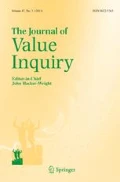Notes
For early and influential formulations of such doubts, see Robert B. Louden, "On some vices of virtue ethics." American Philosophical Quarterly 21, no. 3 (1984): 227-236; Gary Watson, “On the Primacy of Character” in Owen Flanagan and Amelie Rorty, eds., Identity, Character, and Morality, (Cambridge, MA: MIT Press, 1990), 449-70.
See, for example, Jesse Prinz, "The normativity challenge: Cultural psychology provides the real threat to virtue ethics." The Journal of Ethics 13, no. 2-3 (2009): 132-144. Ramon Das, "Virtue ethics and right action." Australasian Journal of Philosophy, 81, no. 3 (2003), 324-339; Ramon Das, "Virtue Ethics and Right Action: A Critique." Routledge Companion to Virtue Ethics. Eds. Besser, Lorraine L., and Michael Slote (Abingdon, UK: Routledge 2015), 331-344. David Copp and David Sobel, "Morality and virtue: An assessment of some recent work in virtue ethics," Ethics 114, no. 3 (2004): 514-554.
See, Julia Annas, Intelligent virtue (Oxford University Press, 2011), 1.
Annas discusses this aspect of the analogy in greater detail in her book The Morality of Happiness (Oxford University Press, 2011), 66-84.
The distinction I make here between acting successfully from mere experience and from skill draws from Aristotle’s distinction between empeiria and techne, in Metaphysics A.1 and in Nicomachean Ethics 1140 a 20–21. Annas discusses this distinction in The Morality of Happiness 66-67.
Annas, Intelligent virtue, 18.
See, Annas, Intelligent Virtue, 39-40.
For an earlier version of Annas’s understanding of the interconnections between virtue and goodness see The Morality of Happiness. Especially pp. 66-84.
It should be noted that skill can be used not only to bring about its characteristic aim; rather, it is a two-way capacity, meaning that by mastering the reasons of a craft one has the rational capacity to both bring the characteristic product and destruct it. See, Aristotle, Metaphysics, Θ.2, 1046b4–7. By contrast, acting in a non-virtuous manner is never a demonstration of virtue. See Aristotle, Nicomachean Ethics, 1140b23.
See, for example, Rosalind Hursthouse, On Virtue Ethics (Oxford: Oxford University Press, 2000), Chapter 1; John McDowell, “Virtue and Reason.” The Monist 62, no. 3 (July 1, 1979): 331–50.
Hursthouse, On Virtue Ethics, p. 28.
Louden, “On Some Vices of Virtue Ethics,” 229.
Robert N. Johnson, "Virtue and Right," Ethics 113, no. 4 (2003): 810
Das, "Virtue Ethics and Right Action."
Moreover, Intelligent Virtue consists of important contributions to these discussions. For an insightful review of some of the main contributions, see Daniel C. Russell’s "Virtue, Skill and Intelligence: Julia Annas's Intelligent Virtue." The Philosophical Quarterly, vol. 64, no.255 (2014): 308-315.
Watson, “The Primacy of Character.”
Annas, Intelligent Virtue, 39.
Ibid, 40.
Ibid.
Throughout Intelligent Virtue, one finds examples to the effect that courage, as well as other virtues, require a grasp of valuable aims. See, Intelligent Virtue, 84-85, 101-102 and 160-161.
Cf. Thomas Hurka, Virtue, vice, and value. (Oxford University Press, 2000), 3; and Watson, “The Primacy of Character.”
Thus, the aim of skill can be bad if it is employed in the service of bad ends. For instance, the expert bridgebuilder can build a bridge that will serve to conquer, destroy and plunder a city.
Annas, Intelligent Virtue, 110.
In this vein, Thomas Hurka writes that “it is intrinsically good to be oriented positively toward good and negatively toward evil." Hurka, Virtue, Vice and Value, 17. Reconciling virtue’s intrinsic value with consequential and deontological ethical theories is a great contribution of Hurka’s book.
For examples for this kind of ethics, see Hurka, Virtue, vice, and value; and Julia Driver, Uneasy Virtue (Cambridge: Cambridge University Press, 2001). Annas’s own work, at least since The Morality of Happiness, provides a powerful response to this kind of criticism which I will present in the final section.
Cf. Hurka, Virtue, vice, and value, Chapter 1.
See, for example, Hursthouse, On Virtue Ethics, Chapter 8).
Cf. Hurka’s criticism of this kind of virtue ethics (see, Hurka, Virtue, vice, and value, 239-240).
In earlier work Annas states very clearly her objection to reductive theories in normative ethics, and, drawing on ancient philosophers, she develops a non-reductive variant of virtue ethics. See The Morality of Happiness, 8-10.
Thus, she writes: “exercising virtue is a commitment on the part of the virtuous person to goodness because it is goodness: goodness is not just an outcome.” Intelligent Virtue, 116.
Ibid, 104.
Ibid, 103.
Ibid, 156
Ibid, 109, 115, 155-156 and 162.
Ibid, 162.
References
Annas, Julia. 1993. The Morality of Happiness. Oxford: Oxford University Press.
Annas, Julia. 2011. Intelligent Virtue. Oxford: Oxford University Press.
Copp, David, and David Sobel. 2004. Morality and Virtue: An Assessment of Some Recent Work in Virtue Ethics. Ethics 114 (3): 514–554.
Das, Ramon. 2003. Virtue Ethics and Right Action. Australasian Journal of Philosophy 81 (3): 324–339.
Das, Ramon. 2015. Virtue Ethics and Right Action: A Critique. In Routledge Companion to Virtue Ethics, ed. Lorraine L. Besser and Michael Slote, 331–344. Abingdon, UK: Routledge.
Driver, Julia. 2001. Uneasy Virtue. Cambridge: Cambridge University Press.
Hurka, Thomas. 2000. Virtue, Vice, and Value. Oxford: Oxford University Press.
Hursthouse, Rosalind. 1999. On Virtue Ethics. Oxford: Oxford University Press.
Johnson, Robert N. 2003. Virtue and Right. Ethics 113 (4): 810–834.
Louden, Robert B. 1984. On some Vices of Virtue Ethics. American Philosophical Quarterly 21 (3): 227–236.
McDowell, John. 1979. Virtue and Reason. The Monist 62 (3): 331–350.
Prinz, Jesse. 2009. The Normativity Challenge: Cultural Psychology Provides the Real Threat to Virtue Ethics. The Journal of Ethics 13 (2–3): 117–144.
Russell, Daniel C. 2014. Virtue, Skill and Intelligence: Julia Annas’s Intelligent Virtue. The Philosophical Quarterly 64 (255): 308–315.
Watson, Gary. 1990. On the Primacy of Character. In Identity, Character, and Morality, ed. Owen Flanagan and Amelie Rorty, 449–470. Cambridge, MA: MIT Press.
Author information
Authors and Affiliations
Corresponding author
Additional information
Publisher's Note
Springer Nature remains neutral with regard to jurisdictional claims in published maps and institutional affiliations.
Rights and permissions
About this article
Cite this article
Amit, A. The Unity of Virtue and Goodness. J Value Inquiry 55, 339–354 (2021). https://doi.org/10.1007/s10790-021-09819-9
Accepted:
Published:
Issue Date:
DOI: https://doi.org/10.1007/s10790-021-09819-9

